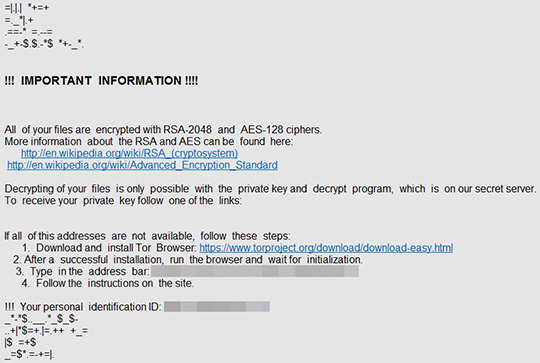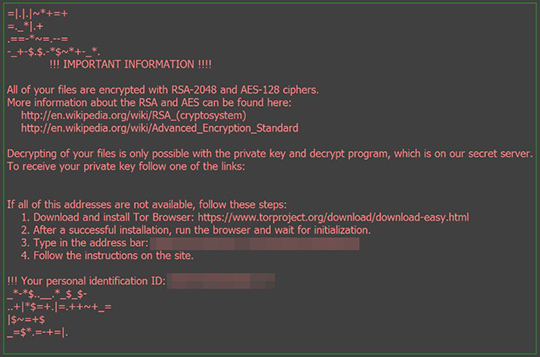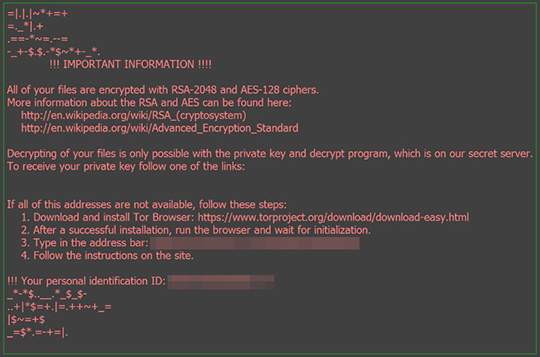RANSOM_LOCKY.TH918
Ransom.Lukitus (Symantec); Ransom:Win32/Locky.A (Microsoft); Trojan-Ransom.Win32.Locky.ziz (Kaspersky)
Windows


Threat Type: Ransomware
Destructiveness: No
Encrypted: Yes
In the wild: Yes
OVERVIEW
This Ransomware arrives on a system as a file dropped by other malware or as a file downloaded unknowingly by users when visiting malicious sites.
It modifies the Internet Explorer Zone Settings.
It deletes itself after execution.
It encrypts files with specific file extensions. It drops files as ransom note.
TECHNICAL DETAILS
Arrival Details
This Ransomware arrives on a system as a file dropped by other malware or as a file downloaded unknowingly by users when visiting malicious sites.
Installation
This Ransomware drops and executes the following files:
- %Desktop%\ykcol.htm -> ransom note
- %Desktop%\ykcol.bmp -> ransom note, also used as the background image
(Note: %Desktop% is the desktop folder, where it usually is C:\Documents and Settings\{user name}\Desktop in Windows 2000, Windows Server 2003, and Windows XP (32- and 64-bit); C:\Users\{user name}\Desktop in Windows Vista (32- and 64-bit), Windows 7 (32- and 64-bit), Windows 8 (32- and 64-bit), Windows 8.1 (32- and 64-bit), Windows Server 2008, and Windows Server 2012.)
Other System Modifications
This Ransomware changes the desktop wallpaper by modifying the following registry entries:
HKEY_CURRENT_USER\Control Panel\Desktop
Wallpaper = "%Desktop%\ykcol.bmp"
HKEY_CURRENT_USER\Control Panel\Desktop
TileWallpaper = 0
HKEY_CURRENT_USER\Control Panel\Desktop
WallpaperStyle = 0
It sets the system's desktop wallpaper to the following image:
Web Browser Home Page and Search Page Modification
This Ransomware modifies the Internet Explorer Zone Settings.
Other Details
This Ransomware does the following:
- This ransomware opens the dropped %Desktop%\ykcol.htm which contains the ransom note.

- It also opens the dropped %Desktop%\ykcol.bmp which is also the desktop wallpaper that contains the ransom note.

It deletes itself after execution.
Ransomware Routine
This Ransomware encrypts files with the following extensions:
- .001
- .002
- .003
- .004
- .005
- .006
- .007
- .008
- .009
- .010
- .011
- .123
- .1cd
- .3dm
- .3ds
- .3fr
- .3g2
- .3gp
- .3pr
- .602
- .7z
- .7zip
- .aac
- .ab4
- .accdb
- .accde
- .accdr
- .accdt
- .ach
- .acr
- .act
- .adb
- .adp
- .ads
- .aes
- .agdl
- .ai
- .aiff
- .ait
- .al
- .aoi
- .apj
- .apk
- .arc
- .arw
- .asc
- .asf
- .asm
- .asp
- .aspx
- .asset
- .asx
- .avi
- .awg
- .back
- .backup
- .backupdb
- .bak
- .bank
- .bat
- .bay
- .bdb
- .bgt
- .bik
- .bin
- .bkp
- .blend
- .bmp
- .bpw
- .brd
- .bsa
- .bz2
- .cdf
- .cdr
- .cdr3
- .cdr4
- .cdr5
- .cdr6
- .cdrw
- .cdx
- .ce1
- .ce2
- .cer
- .cfg
- .cgm
- .cib
- .class
- .cls
- .cmd
- .cmt
- .config
- .contact
- .cpi
- .cpp
- .cr2
- .craw
- .crt
- .crw
- .cs
- .csh
- .csl
- .csr
- .css
- .csv
- .d3dbsp
- .dac
- .das
- .dat
- .db
- .db3
- .db_journal
- .dbf
- .dbx
- .dc2
- .dch
- .dcr
- .dcs
- .ddd
- .ddoc
- .ddrw
- .dds
- .der
- .des
- .design
- .dgc
- .dif
- .dip
- .dit
- .djv
- .djvu
- .dng
- .doc
- .docb
- .docm
- .docx
- .dot
- .dotm
- .dotx
- .drf
- .drw
- .dtd
- .dwg
- .dxb
- .dxf
- .dxg
- .edb
- .eml
- .eps
- .erbsql
- .erf
- .exf
- .fdb
- .ffd
- .fff
- .fh
- .fhd
- .fla
- .flac
- .flf
- .flv
- .flvv
- .forge
- .fpx
- .frm
- .fxg
- .gif
- .gpg
- .gray
- .grey
- .groups
- .gry
- .gz
- .hbk
- .hdd
- .hpp
- .html
- .hwp
- .i
- .ibank
- .ibd
- .ibz
- .idx
- .iif
- .iiq
- .incpas
- .indd
- .iwi
- .j
- .jar
- .java
- .jnt
- .jpe
- .jpeg
- .jpg
- .js
- .kc2
- .kdbx
- .kdc
- .key
- .kpdx
- .kwm
- .l
- .la
- .laccdb
- .lay
- .lay6
- .lbf
- .ldf
- .lit
- .litemod
- .litesql
- .log
- .ltx
- .lua
- .m
- .m2ts
- .m3u
- .m4a
- .m4p
- .m4u
- .m4v
- .mapimail
- .max
- .mbx
- .md
- .mdb
- .mdc
- .mdf
- .mef
- .mfw
- .mid
- .mkv
- .mlb
- .mml
- .mmw
- .mny
- .moneywell
- .mos
- .mov
- .mp3
- .mp4
- .mpeg
- .mpg
- .mrw
- .ms11
- .ms11 (security copy)
- .msg
- .myd
- .myi
- .n64
- .nd
- .ndd
- .ndf
- .nef
- .nk2
- .nop
- .nrw
- .ns2
- .ns3
- .ns4
- .nsd
- .nsf
- .nsg
- .nsh
- .nvram
- .nwb
- .nx2
- .nxl
- .nyf
- .oab
- .obj
- .odb
- .odc
- .odf
- .odg
- .odm
- .odp
- .ods
- .odt
- .ogg
- .oil
- .onetoc2
- .orf
- .ost
- .otg
- .oth
- .otp
- .ots
- .ott
- .p12
- .p7b
- .p7c
- .pab
- .pages
- .paq
- .pas
- .pat
- .pcd
- .pct
- .pdb
- .pdd
- .pef
- .pem
- .pfx
- .php
- .pif
- .pl
- .plc
- .plus_muhd
- .png
- .pot
- .potm
- .potx
- .ppam
- .pps
- .ppsm
- .ppsx
- .ppt
- .pptm
- .pptx
- .prf
- .ps
- .psafe3
- .psd
- .pspimage
- .pst
- .ptx
- .pwm
- .py
- .qba
- .qbb
- .qbm
- .qbr
- .qbw
- .qbx
- .qby
- .qcow
- .qcow2
- .qed
- .r3d
- .raf
- .rar
- .rat
- .raw
- .rb
- .rdb
- .re4
- .rm
- .rtf
- .rvt
- .rw2
- .rwl
- .rwz
- .s3db
- .safe
- .sas7bdat
- .sav
- .save
- .say
- .sch
- .sd0
- .sda
- .sdf
- .sh
- .sldm
- .sldx
- .slk
- .sql
- .sqlite
- .sqlite3
- .sqlitedb
- .sr2
- .srf
- .srt
- .srw
- .st4
- .st5
- .st6
- .st7
- .st8
- .stc
- .std
- .sti
- .stm
- .stw
- .stx
- .svg
- .swf
- .sxc
- .sxd
- .sxg
- .sxi
- .sxm
- .sxw
- .tar
- .tbk
- .tex
- .tga
- .tgz
- .thm
- .tif
- .tiff
- .tlg
- .txt
- .uop
- .uot
- .upk
- .vb
- .vbox
- .vbs
- .vdi
- .vhd
- .vhdx
- .vmdk
- .vmsd
- .vmx
- .vmxf
- .vob
- .wab
- .wad
- .wallet
- .wav
- .wb2
- .wk1
- .wks
- .wma
- .wmv
- .wpd
- .wps
- .x
- .x11
- .x3f
- .xis
- .xlam
- .xlc
- .xlk
- .xlm
- .xlr
- .xls
- .xlsb
- .xlsm
- .xlsx
- .xlt
- .xltm
- .xltx
- .xlw
- .xml
- .y
- .ycbcra
- .yuv
- .zip
It avoids encrypting files with the following strings in their file path:
- _Locky_recover_instructions.txt
- _Locky_recover_instructions.bmp
- System Volume Information
- _HELP_instructions.html
- _HELP_instructions.bmp
- _HELP_instructions.txt
- Program Files (x86)
- Application Data
- Program Files
- $Recycle Bin
- thumbs.db
- AppData
- Windows
- winnt
- Boot
- temp
- tmp
It renames encrypted files using the following names:
- {first 8 characters of ID}--{next 4 characters of ID}--{last 4 characters of ID}--{8 hex characters}--{12 hex characters}.ykcol
It drops the following file(s) as ransom note:
- {Folder containing encrypted files}\ykcol-{4 hex letters}.htm
SOLUTION
Step 1
Before doing any scans, Windows XP, Windows Vista, and Windows 7 users must disable System Restore to allow full scanning of their computers.
Step 2
Note that not all files, folders, and registry keys and entries are installed on your computer during this malware's/spyware's/grayware's execution. This may be due to incomplete installation or other operating system conditions. If you do not find the same files/folders/registry information, please proceed to the next step.
Step 3
Search and delete these files
- %Desktop%\ykcol.htm
- %Desktop%\ykcol.bmp
- {Folder containing encrypted files}\ykcol-{4 hex characters}.htm
Step 4
Reset your Desktop properties
Step 5
Reset Internet security settings
Step 6
Scan your computer with your Trend Micro product to delete files detected as RANSOM_LOCKY.TH918. If the detected files have already been cleaned, deleted, or quarantined by your Trend Micro product, no further step is required. You may opt to simply delete the quarantined files. Please check this Knowledge Base page for more information.
Step 7
Restore encrypted files from backup.
Did this description help? Tell us how we did.


